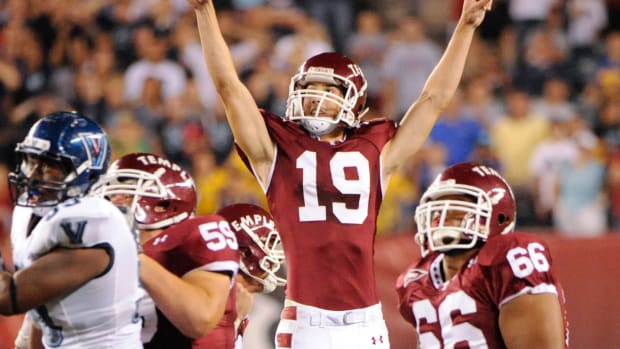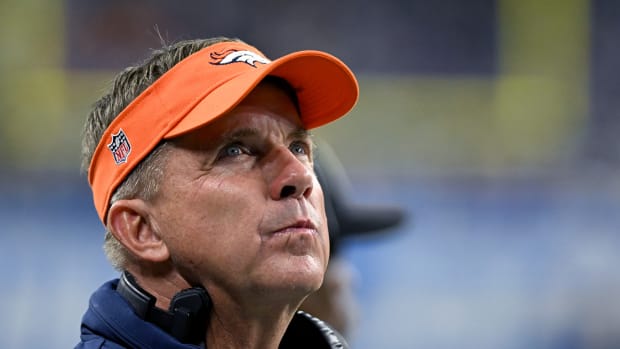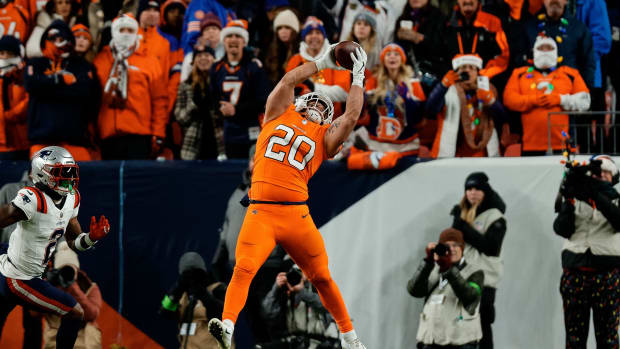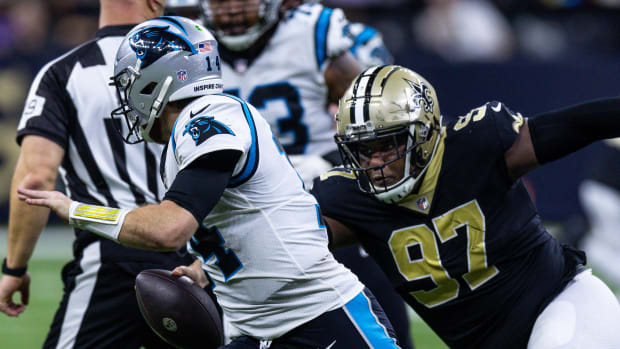Need for Speed: Where the Broncos Have Fallen Behind Teams Like the Chiefs, Niners
And just like that, only one football game (that counts) remains before the NFL season is officially over. With the San Francisco 49ers beating up the Green Bay Packers 37-20 and the Kansas City Chiefs defeating the Tennessee Titans 35-24, two of the better teams of the past season shall be squaring off in Miami on February 2nd for a chance to earn the title of World Champion.
The Niners and Chiefs are two of the more talented teams in the NFL and undoubtedly deserve the position they're currently in.
With reigning NFL MVP Patrick Mahomes tossing the ball around the yard in the Andy Reid offense, making absurd highlights escaping the pocket, throwing off-platform, and delivering incredible throws down the field with touch and arm strength, to the Niners' insanely efficient and deadly rushing attack, running for 285 yards, for 6.8 yards per attempt on 42 carries compared to just eight pass attempts (eight! In the modern NFL!), both these teams have found ways to score points this season despite having different offensive philosophies.
While it is true that Reid and Niners' head coach Kyle Shanahan both have roots that can be traced back all the way to Bill Walsh and the original West Coast Offense, the games and the schemes have diverged drastically over the nearly half a decade since Walsh was coaching in the NFL. Reid has trended towards an offense that is far more shotgun and pass-heavy where the run game is more of a compliment than an actual major part of the game plan. With a talent like Mahomes, it shouldn't be a shock that Reid wants to throw the ball early and often.
Shanahan, however, has built an offense based more on the rushing attack. With heavy usage of the outside zone, a staple of any zone-blocking scheme, Shanahan has done an amazing job diversifying the rushing concepts with plenty of inside zone, traps, pulls, and counters also involved.
Shanahan's offense can pass when needed and oftentimes with play-action involved, but so far the ground game and defense have dominated enough to not put so much on the quarterback or passing game. When Shanahan does go to the passing well, expect an explosive play to be the end result. Both Reid and Shanahan are obviously offensive masterminds, but they find their explosive plays and points in different ways.
What is the biggest common denominator between these two Super Bowl offenses that the Denver Broncos do not possess? First, let's examine the misconception on what the gulf between the Broncos and these competitors are.
A Good Enough O-Line
While it has become canon that the Broncos’ offensive line is ‘bad’, looking at the individual talent of both the Chiefs' and Niners' lines would leave one wanting.
The Niners do have three former first-round picks on their O-line, but Joe Staley is well into the back-nine of his career, while Mike McGlinchey has been good but not great and very much protected by the scheme (see his game versus Danielle Hunter in the NFC Divisional Round). It was turning into a Michael Schofield vs. Khalil Mack special if not for the Niners' ground attack and defense netting them the lead).
The tackles are fine, but the interior leaves a fair amount to be desired. Laken Tomlinson was a ‘bust’ who's now playing decently at left guard, with Ben Garland at center (former Broncos’ defensive lineman from the Air Force Academy) and Mike Pearson at right guard. The output by the Niners' offensive line points more towards scheme, execution, and cohesion as opposed to individual talent.
Of course, it doesn’t hurt to have the best fullback in Kyle Juszczyk and George Kittle — on of the league's top dual-threat tight ends — to help, especially with outside zone rushes.
The same holds true for the Chiefs. While Mitchell Schwartz is one of the three best right tackles in football, the rest of the offensive line leaves a lot to be desired on paper. Eric Fisher is one of the more underwhelming first overall picks of the last decade, although the 2013 draft class, in general, was rather a dud.
Fisher is at best solid, bordering-on-average for a starting left tackle. Furthermore, the interior of the line mimics much of the Niners. Right guard Laurent Duvernay-Tardif is solid but has been trending downward over the past few seasons as injuries have hampered him a bit, and AFC Championship Game starters in left guard Stefen Wisniewski and center Austin Reiter are nothing to write home about.
Undoubtedly, the pocket magician that is Mahomes helps his line, as well as the scheme, but the unit's overall talent is closer to Denver than one would think at first glance.
In reality, neither team is flush with O-line talent. The scheme, as well as the pieces surrounding the line, have been able to help cover up deficiencies as the sum of the unit has outperformed individual talent along the offensive front.
This has not been the case for Denver, but a healthy unit for the Broncos of Garett Bolles, Dalton Risner, Connor McGovern, Ronald Leary, and Ja’Wuan James would have been right there with the talent of either team going to the Super Bowl this season. Furthermore, another season under the tutelage and development of O-line Coach Mike Munchak, as well as a heaping of resources in cap space and early draft capital, points to the line having even more potential going forward in the Mile High City.
The Broncos' offensive line needs to improve, but that hill is a much shorter climb than many would think.
Need for Speed
Outside of the obvious in the play callers and scheme designers in Reid and Shanahan, the biggest difference between the Broncos’ offense and that of the AFC and NFC Champions is simple; the Chiefs and the Niners have speed across their entire offense, while the Broncos simply are not.
According to NFL Next Gen Stats, the No. 1 and 2 NFL teams in 2019 in average top speed by offensive ball-carriers were the Chiefs (13.36 MPH) and the 49ers (13.35 MPH). The next highest in the league were the Los Angeles Rams (13.31), the Minnesota Vikings (13.31) and the Baltimore Ravens (13.30).
Looking at the types of skill position players these two teams have cultivated and are playing large roles, the emphasis on speed and the ability to create explosive plays has been obvious for both the Chiefs and the Niners.
Of course, the Chiefs have the fastest player in the NFL in Tyreek Hill. He is a man-coverage killer and can win in almost every facet of an offense. With jet sweeps, screens, and deep passes, Hill shows off the ability to make explosive plays vertically or after the catch.
Hill is such a dynamic speed player he legitimately dictates coverage and changes how defenses can attack the Chiefs. Kansas City didn’t stop with Hill though. Rostering Damien Williams (4.45-second 40), Travis Kelce (4.61s 40), Mecole Hardman (4.33s 40), and Sammy Watkins (4.33s 40), the Chiefs have an abundance of speed littered across their skill positions.
Again, the Chiefs have a far greater reliance on the passing game whereas the Niners lean more on the run, but that hasn’t stopped San Francisco from going out there and getting speed and playmakers at the skill positions. While the starting two wide receivers of Deebo Samuel (4.48s 40) and Emmanuel Sanders (4.41s 40) aren’t blazing at the same rate as their Kansas City counterparts, they offer explosiveness as much after the catch as down the field.
Get either in space and good things can happen. The same can be said of Kittle who not only obliterates as a run blocker but is incredibly dangerous down the field or after the catch with his 4.51-second 40 speed, which is blazing for a tight end.
Being a more run-heavy team though, the Niners find speed aplenty at running back. While many teams look for more complementary skill-sets at running back, looking to pair thunder with lightning, the Niners have instead stacked speed on top of speed. Rostering Tevin Coleman (4.39s 40), Matt Breida (4.38s 40), and Raheem Mostert (4.42s 40), the Niners have told the slow plodders to hit the road and instead are looking for explosive ball carriers that can find a lane and explode upfield.
The Broncos, unfortunately, will be winning approximately zero track races against the Niners or the Chiefs. While the Broncos did take a step in the right direction in obtaining breakaway athleticism in the 2019 draft, nabbing the athletic dynamo in tight end Noah Fant, the offense simply lacks players that dictate coverage because they are such a home run threat.
Pale in Comparison
The Broncos also are fortunate that they have found a very high ceiling for the X-receiver in Courtland Sutton. While Sutton and his 4.54-second 40 will never be considered a ‘burner’, his overall size, strength, agility, and ability to beat press-coverage and play above the rim make him a deep threat, he just doesn’t dictate coverage like a truly dynamic speed threat does in an offense.
Furthermore, Sutton started to show out so well last season that teams started to game-plan to take Sutton out of the game because none of the Broncos’ weapons were great enough to worry opponents. The ‘we are not letting that guy beat us’ is as much of a testament to Sutton as it is a lack of respect to the Broncos’ other weapons.
The Broncos do have some speed and explosiveness in the run game with Phillip Lindsay, who ran a 4.44-second 40 at his Pro Day, but to date, his explosiveness has not translated at all to the passing game. Blame the wrist or blame the offense, either way, the thought that any small, fast running back can be a dynamic receiving threat has not come close to reality in regards to Lindsay in his first two seasons in the NFL.
It isn’t just that the Chiefs and Niners have incredible speed at the skill positions either, but rather just the volume of weapons each team has at their disposal. While DaeSean Hamilton and Tim Patrick have had flashes in Denver, both have defects in their game that point to neither being anything better than depth options in the NFL for a good offense.
Hamilton has shown some route savviness but he offers little to none after the catch or vertically. Patrick has a fun combination of height, weight, and speed but has shown to be a much more linear athlete to date that can’t stay healthy. He’s a better backup X to Sutton than a top-three receiving option on the team. After Fant, Sutton, and Lindsay, the arsenal is depressingly empty.
Don't Underestimate the Scheme
To be completely fair to the Broncos as well as the Chiefs and the Niners, the fact that the they're the top-two teams in average top speed for ball-carries in 2019 has as much to do with the scheme and system of the offenses as it does the players on the roster. The cliche is ‘it’s about the Jimmies and Joes as opposed to the Xs and Os’ is true, but has become the norm in football from college to the NFL.
The game has evolved to where getting the ball to explosive playmakers quickly and with room to roam is what it all comes down to. A scheme can help get a guy open, but it takes the right athlete to create and take advantage of the situation.
In the end, it should be no surprise that the fastest teams recorded through the 2019 regular season ended up being the Chiefs and the 49ers. While their systems do branch from the WCO tree, the Niners and their heavy usage of the run game on top of 12 (1 RB, 2TE) and 21 (2RB, 1TE) personnel — as opposed to the pass-happy 11 personnel (1 RB, 1 TE, 3WR) of the Chiefs — both accomplished the same feat but in different ways.
Each team has a good enough offensive line and gets the ball to explosive playmakers to let them do their thing. Not only do these weapons create explosive plays for their offenses, but because the sheer volume of talent and speed they create spacing for others on offense, further feeding steam to the finely tuned engines that are these two teams’ offenses. It’s a speed in spacing game.
This should not be that surprising in hindsight, and it does appear the Broncos are well aware of this need. With GM John Elway discussing the need for wide receiver help multiple times already this offseason, the team targeting both John Brown in free agency and John Ross as a trade target, on top of the reporting of Ben Allbright, Mike Klis, and Woody Paige all pointing at receivers such as Henry Ruggs and Jalen Reagor in the draft, the Broncos might as well tweet out a Top Gun “I feel the need… the need for speed” GIF every day through the rest of the offseason.
The Takeaway
The Broncos may not have a Mahomes quarterback like the Chiefs do even despite the promise of Drew Lock. Denver may not have the best fullback/tight end in the game like the Niners do (on top of the best defensive front seven in football).
The Broncos may not have a truly incredible play designer like Reid and Shanahan who are transcendent offensive schemers in the NFL. It would be hard, bordering on impossible, to replicate any of those situations either.
However, looking at the massive volume of dynamic weapons on both the Super Bowl participants that can not only create plays for themselves but dictate coverage and create space others, the Broncos’ talent, speed, and explosiveness pales in comparison.
The Broncos’ offensive line is closer to these Conference champions than meets the eye, but without the weapons to help create explosive plays, dictate coverage, give Pat Shurmur and Lock options, it’s going to be a long, uphill battle to ever come close to the offensive output needed to keep up with the big dogs in today’s NFL.
Follow Nick on Twitter @NickKendellMHH and @MileHighHuddle.





